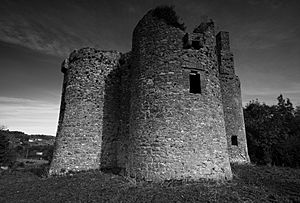Ballinafad Castle facts for kids
Ballinafad Castle is an old, ruined castle in County Sligo, Republic of Ireland. You can find it near the town of Ballinafad, right next to the N4 highway. It sits on a hill, looking out over a beautiful lake called Lough Arrow.
Contents
Visiting Ballinafad Castle
What to Expect When You Visit
Ballinafad Castle is a ruin, but you can visit it any time of year. There are no special tours or guides, and it's free to enter. You can park your car in a small area at the bottom of the hill. Look for a sign there that tells you more about the castle's history.
To reach the castle, just walk up the path from the parking area. You'll go through a small iron gate to enter the castle grounds. While you can't go inside the castle walls, you can see parts of the interior through openings in the walls. These openings are safely closed off with iron fences.
The History of Ballinafad Castle
When Was Ballinafad Castle Built?
Ballinafad Castle was built a long time ago, around the year 1590. It was constructed during a big conflict known as the Nine Years' War. This war took place in Ireland from 1593 to 1603. The castle was designed in a style called Elizabethan architecture, which was popular during the time of Queen Elizabeth I of England.
Who Built Ballinafad Castle?
The castle was built by a person named Captain John St. Barbe. He received the land for the castle from King James I. King James I was the ruler of England, Scotland, and Ireland at that time. Captain St. Barbe's castle was like a strong blockhouse, built to help control the area during the war.
What Happened to the Castle?
Ballinafad Castle was guarded by about ten soldiers, and Captain John St. Barbe was in charge of them. However, the castle faced attacks during the war. In 1595, a famous Irish leader named Red Hugh O'Donnell partly destroyed the castle.
Later, in 1642, the castle was attacked and damaged again. After this, it slowly fell out of use. By the year 1680, Ballinafad Castle was no longer used as a fortress and became the ruin you see today.


